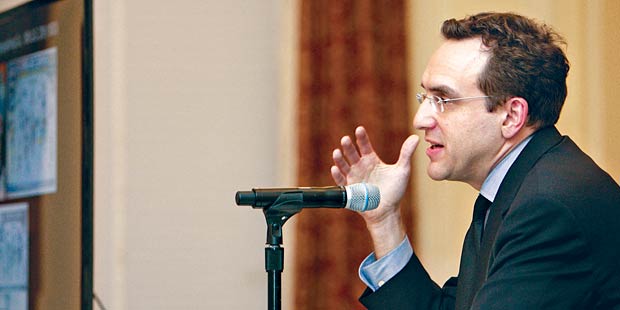What’s the (Fair) Use?
Printer Friendly VersionThe latest incarnation of the Internet—Web to consider the relation between the aesthetic and 2.0—is the phenomenon of user-generated content. Pop culture consumers three decades ago watched professionally produced videos on MTV; the same people today sit in front of their screens, taking clips of music or videos and making their own works (or parodies) to share with the world. To Barton Beebe, viral puppy videos and Ryan Gosling memes underscore how far behind the times copyright law is in examining the concept of aesthetic progress.
In late January, Beebe expounded on his views in “Intellectual Property Law and the Problem of Aesthetic Progress,” his inaugural lecture as the John M. Desmarais Professor of Intellectual Property Law. Aesthetic progress is an admittedly murky concept. In both statutes and case law, the stated purpose of intellectual property law is to promote progress in the arts and sciences. For scientific and technological knowledge, progress means improving on the last thing, making something more efficient, or building something that replaces something new. Progress in the arts, however, doesn’t mean that the works of Picasso are better than cave drawings, Beebe said. Instead, the art is often something totally new and different, and part of the reason the artist creates it is for the joy of doing so. That creative process, however, has no value under current law.
The Intellectual Property Clause empowers Congress “to promote the Progress of Science and useful Arts” through the provision of copyright and patent rights. But strangely missing from this constitutional language is any reference to the fine arts, which qualify neither as “science” nor as “useful Arts” (technology). Why, Beebe wonders, might the framers have taken pains to exclude the fine arts in this context?
The early 20th century “would have been an especially appropriate time for intellectual property law progress,” Beebe said in his lecture. But the opportunity was missed. In 1903, the Supreme Court held in Bleistein v. Donaldson Lithographing Co. that circus advertisements could receive copyright protection even if they were not fine art. Rather than opening the door to further discussion of aesthetic progress, however, the opinion turned out to be a “conversation-stopper” on the topic, said Beebe.
“For two centuries, we have viewed copyright law essentially as industrial policy with long-term accumulation as its goal,” Beebe said. And while he conceded that that’s a good thing, he added: “We also need to view it as cultural policy with short-term, even immediate, aesthetic experience as its competing goal.”
That doesn’t mean that judges should engage in “aesthetic discrimination,” nor does copyright law need to be turned on its head, said Beebe. “But I am suggesting that we have every right ourselves, as the crowd, to promulgate a form of copyright law” that might be more lenient in consideration of how works are treated now, he said. For example, Beebe suggested, it might be time to revisit enforcement of the reproduction right that gives copyright holders the sole right to reproduce their work and might prevent, say, the cute-cat video maker from using images and clips of others’ work to include in his own.
Opening up the conversation about aesthetic progress and what it means could lead to tweaks to copyright law that are more in line with today’s hands-on approach to cultural commentary, Beebe said. In other words, in the age of Web 2.0, it’s high time to reassess the impact of a more-than-century-old precedent.
—

